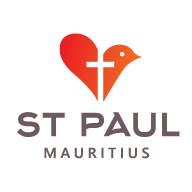A Missionary Church
It all began on 2 October 1863 with the laying of the foundation stone of what would later be St Paul’s Church, Plaine Verte. The building which was made of wood and stone at the cost of £ 3,500 (i.e. about Rs 140,000 at the current exchange rate) was consecrated on 27 August 1864. The building was used mainly for congregations consisting of indian and french people. It has to be noted that the funds required for the construction has been mainly contributed by the parishioners themselves.
This building was later severely damaged following the visit of a cyclone in 1868. It was rebuilt in 1870 and its architecture has remained more or less the same to what we have today. The roof was rebuilt in 1961 after the strike of cyclones Alix and Carol which caused much havoc in the island. The building was renovated in 1996.
In 2017-2018, the whole roof was rebuilt with metallic structures but keeping the same architecture as the original building. Just like the apostle Paul has been one of the greatest missionaries of all times, St Paul’s Church, Plaine Verte has always had a missionary calling, whether among the Indians, the Muslims or the Chinese.
A Multi-Cultural Congregation
Among the Indians
St Paul’s Church, Plaine Verte was first used as a centre for the missionary work among the Indians who came to Mauritius from India. In this way St Paul’s Church became the Christian Indian Association centre , an organization whose objective was to bring the good news of the gospel to the indian immigrants. One of the missionaries who had devoted body and soul for this mission was the Rev. Charles Kooshalee who served the parish for 25 years and helped in the conversion of nearly 2000 Indians. Historical records relate to us that during the celebration of the Eucharist, prayers were said in Bengali, songs were in Hindoustani, the Gospel in Tamil and in Bengali, the sermon in English or French and translated in Bengali.
Among the Muslims
St Paul’s Church, Plaine Verte is located in Port Louis in a predominantly Muslim environment and we are daily reminded of this when we hear the “muezzin” calling Muslims to prayer. But many of us would perhaps be surprised to know that at a point in time, St Paul’s Church was an instrument of evangelism among Muslims. It all began by the conversion of a merchant from Persia in 1873. More than 20 years earlier in Persia, the latter believed in his heart that Jesus Christ was the Son of God and that Christianity was the only true religion. He wanted to be baptized but was afraid to confess his faith for fear of being persecuted by his parents. Soon after, he came with his father to work in Mauritius and had the opportunity to meet Christian workers in his job. He accompanied them to church. When his father got to know this, he sent him back to Iran. A few years later, when his father left Mauritius, he decided to come back and was finally baptized at St Paul’s Church, Plaine Verte on 17 August 1873. His name was Mirza Abdul Karim and he adopted the name of George Christian Hope after his baptism. Later, he was persecuted, humiliated and even beaten by Muslims, but this did not stop him from persevering in the way of the Lord. He was even a close co-worker to Rev. Charles Blackburn who dedicated much of his life to bring the good news of the gospel to Indians, and especially to Muslims. Rev. Blackburn who spoke fluent Urdu resisted the Muslims with great zeal and he even wrote a booklet in reaction to arguments from Muslims in November 1890. However, this work was completed after great difficulties.
Among the Chinese
Contrary to popular belief, the missionary work among the Chinese at St Paul’s Church began much later. In 1872, the first Chinese to be converted by the Anglican Church was a shop owner whose name was Ah-Hang and who was living in the Savanne district. Daniel ShouShin, a missionary, did also a good work among the Chinese in Rose-Hill in 1882. Unfortunately, he had to return back to China some time later.
The missionary work among the Chinese did not expand until the 1940’s and 1950’s under the direction of Rev. Victor Donat at St Paul’s Church, Plaine Verte. The latter was actively involved among the Chinese who lived in the eastern suburbs of Port Louis and history tells us that during certain periods of time, entire families were baptized. St Paul’s Church, Plaine Verte thus became the Centre of Chinese Mission. Rev. Victor Donat was supported in his work by Simon Ah-Leung until 1953. In 1955, he managed to get the help of a full-time Chinese missionary in his task. This missionary was Rev. Paul Chung Fong To who arrived in Mauritius in January 1955. Rev. To spoke different Chinese dialects fluently and this helped him a lot in his task to bring the good news to Chinese families. In this way, he tirelessly covered the island from the north to the south and from east to west and even visited Rodrigues. Unfortunately, the Lord called him back when he was in the Cathedral in Hong Kong on 28 May 1959. His spouse, Mrs To, “Muk Si Gniong” for close friends, continued the work of her late husband in a wonderful way. We all know the zeal and the dedication she showed in her missionary work among the sino-mauritians, before she left us to be with her children in England in 1981.
The Charismatic Revival
The charismatic movement started in St Paul’s Church in the late sixties through a small group of Christians fervent in prayer. Among others there were Rev. Lewis Barry, Paul and Noellie Cheng Kai On, Jocelyne Lew Kew Lin, Anne Marie Li Wan Po, Sylvio Ng Kwok Cheung and his family. The movement soon developed rapidly, especially among the youths with the help of a group of brothers and sisters from South Africa among whom was Leslie Pon who spent several months in Mauritius doing missionary work among the youths.
This revival is characterised by a greater freedom in prayer, worship and gifts of the Holy Spirit among which was the gift of “speaking in tongues”. The charismatic revival gave rise to an unprecedented spiritual movement at the parish level and touched not only the youths but also the adults and the elderly.
Rev Roger Chung Po Chuen, who served was deeply involved in the transformation of the parish into a charismatic church.
Cell Church
Up and until the year 1999, St Paul’s church was a church with cells. It had 6 cell groups and only a few people formed part of these groups.
With the visit of the team from the Anglican Diocese of Sabah in 1999 and particularly with the help of the then Archdeacon Alvert Vun, the parish moved into the cell church system. This means that the main activity of the church is the cell groups and where every member is encouraged to form part of a group. Today we have 45 cell groups spread over all age groups and meeting on difference days of the week either at homes or in church.
Evangelisation
As from 2005 (date of first visit Francis Khoo), the parish became actively focused on a new thrust of mission and evangelism. The visits of teams from Singapore and Malaysia: Rev. Francis Khoo of Covenant Vision Centre, the Diocese of Sabah (Bishop Albert Vun, Dean Chak, Rev. Kenneth Thieu), Pastor Michael Hanchett from the US – greatly helped in reaching out people from all walks of life with the gospel of Jesus Christ. Hundreds of people responded to alter calls and accepted Jesus Christ as their personal Lord and Savior.
We also witnessed miraculous healings and deliverance as per the scripture. The congregation at church more than quadrupled.
Today the church is still actively involved in mission and evangelisation spreading the Good news of Jesus Christ to the outside world, healing the sick, delivering the demonized and bringing inner healing to the broken hearted.

